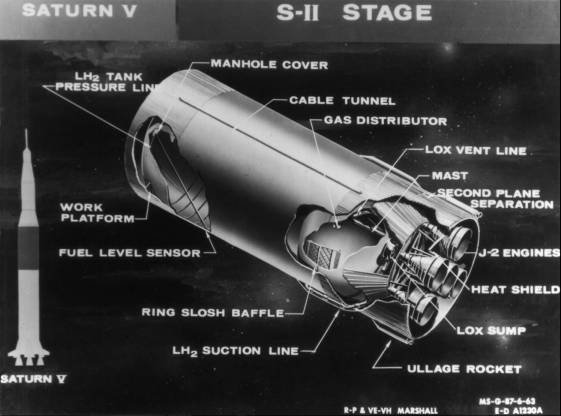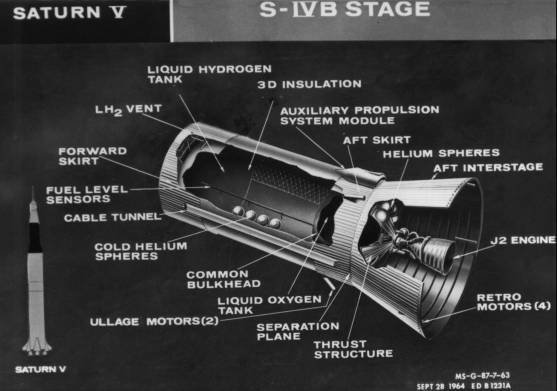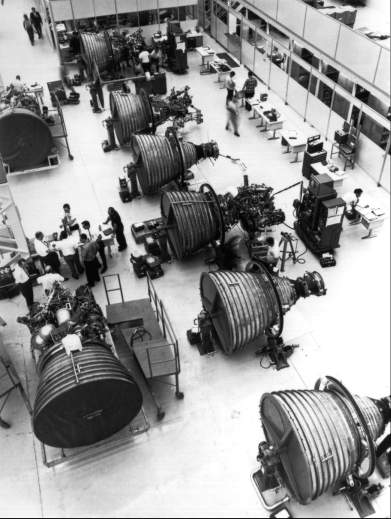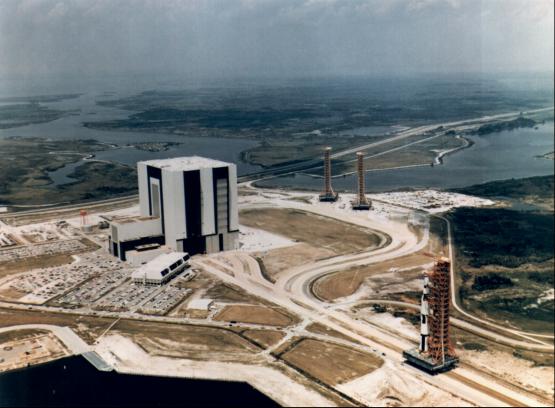
Troubles and Troubleshooters
Saturn IB flights, for the most part, ran smoothly in 1966. Unfortunately, this was not true for all of Apollo. Early in the year, NASA Apollo Program Director Samuel Phillips and a cadre of analysts completed a survey of vehicles and management at North American, after several months of probing into activities at Downey, Seal Beach, and El Segundo. Phillips' group noted that organizational and personnel weaknesses were hampering the contractor's attempts to meet command and service module schedules, but the biggest problem was the S-II second stage of the launch vehicle, which threatened to block the chances of flying an all-up vehicle on the first Saturn V launch.

Saturn's S-II stage

Saturn's S-IVB stage
Despite two successful ground tests, on 29 December 1965 and 12 January 1966, the S-II was behind schedule and in trouble. North American realized this and hired a new manager, Robert E. Greer, a retired Air Force general, to get S-II development back on the track. By spring, Greer and his troops had gone to the Mississippi Test Facility, near the Pearl River north of New Orleans, to begin an intensive ground test program. For 15 seconds on 23 April, the five J-2 liquid-oxygen and liquid-hydrogen engines roared into action, producing the designed thrust of 4.5 million newtons (one million pounds).12

J-2 engines at the Rocketdyne plant in California. Five of these engines propelled by liquid oxygen and liquid hydrogen, were used in the Saturn V's S-II second stage, and one was used in its S-IVB third stage (the S-IVB was also the second stage of the Saturn IB).
Three more firings were attempted - on 10, 11, and 16 May - but the engines were cut off too soon by faulty instrumentation. In two more tests, on the 17th and 20th, the engines fired for 150 and 350 seconds. The next scheduled 350-second test, on 25 May, met problems when fire broke out in two places on the S-II. Three days later, while the stage was being removed from the stand, a liquid-hydrogen tank exploded, injuring five persons and damaging the test stand.13

The first Saturn V rollout, from the VAB, 25 May 1966.
Although it was a gloomy day in Mississippi, 25 May 1966 was still a milestone for Saturn V. Two states away, in Florida, NASA ceremoniously rolled out its 2,700-metric-ton, diesel-powered, steel-link-tread crawler-transporter loaded with the 111-meter-tall, 196,000-kilogram* Apollo-Saturn vehicle. Just before this impressive mass began moving at a snail's pace away from the Vehicle Assembly Building, NASA Deputy Administrator Robert Seamans said: "I for one questioned whether a vehicle the size of Apollo Saturn could get out to the pad . . . or not." It could.14
However well the rollout augured for Apollo's eventual success, right then the S-II stage was in trouble. NASA Manned Space Flight Director George Mueller began sending weekly assessments of S-II progress to J. Leland Atwood, warning the president of North American that the S-II stood a good chance of replacing the lunar module as the pacing item in Apollo. But Atwood already knew it. That was why he had hired Greer - to bring the S-II more attention at a higher level of management.15
Mueller also told Atwood that Phillips, on his return from the West Coast, had pointed out problems with the spacecraft. Both earth-orbital (Block I) and lunar-orbital (Block II) versions of the command module were being plagued during manufacturing by late hardware deliveries from subcontractors and vendors. The most troublesome had been the environmental control unit being developed by AiResearch. Phillips had chided the subcontractor by letter for its poor performance. In October Atwood admitted to Mueller that this system was the most serious threat to meeting spacecraft schedules for the first manned Apollo flight.16
Phillips' troubleshooting set a pattern for Apollo in 1966; many managers and subsystem managers found themselves dealing, often full-time, with the difficulties in getting qualified vehicles to the launch pad. One of the Houston managers who spent a lot of time trying to straighten out some subsystem that was in trouble was Rolf W, Lanzkron. Phillips had asked Shea to send Lanzkron to General Electric in late 1965 to help get the manufacturer of the ground checkout equipment onto the right path. While Lanzkron was there, GE's general manager for the program, Roy H. Beaton, commented in a letter to Phillips:
As you might well guess he beat the living h--- out of us, . . . spurring us on to more effective utilization of our previously mammoth efforts. Despite the bruises, we feel that we are a far more effective organization now as a result of his leadership.17
And Lanzkron traveled elsewhere. On one occasion he went to Phoenix, where the Sperry Company was having a hard time with the guidance and navigation gyroscopes. For several years, Sperry had been using a commercial detergent, one that many housewives use for washing dishes, to remove grease from the gyro's bearings. Suddenly something went wrong - the grease was not coming off. Baffled at first, Lanzkron and Sperry's own troubleshooters finally discovered that Procter and Gamble had changed its product to include an additive that was supposed to make it better for dishwashing.
It may have helped the housewife, but the "improved" product certainly hindered the cleaning of the bearings.18 Solving the gyro problem was a minor achievement in getting systems ready for flight. Over in the state of New York, however, more complex technical, financial, and managerial problems would demand the attention of many, many troubleshooters.
* Dry weight - fully loaded with fuel and oxidizer, it weighed 2,766,000 kilograms.
12. Maj. Gen. Samuel C. Phillips, NASA Hq., to J. Leland Atwood, NAA, 19 Dec. 1965, with enc.; North American news release N-2, 25 Jan. 1966; NASA, Astronautics and Aeronautics, 1966, pp. 14, 147.
13. Phillips to Dep. Admin., NASA, "S-II All-Systems Static Firings," 17 May 1966, and, same subj., 25 May 1966, with enc., "S-II All-Systems Static Firing Information"; George F. Esenwein, NASA Hq., to Dir., Apollo Test, "May 25, attempted S-II-T full duration static firing," 26 May 1966, with enc.; Savage note to Phillips, "Flash report from Mr. Savage," 27 May 1966, with enc., Esenwein to Dir., Apollo Test, "S-II-T Status," 27 May 1966; Leo L. Jones, "A Brief History of Mississippi Test Facility, 1961-1966," comment ed., MSFC Hist. Off., 24 March 1967, pp. 75-77.
14. NASA, "Rollout Ceremony, Saturn V Facility Vehicle (500-F)," press conference, 25 May 1966.
15. Mueller to Atwood, 23 Feb. 1966, with enc., "S-II Stage Weekly Assessment," and 31 March 1966; Atwood to Mueller, 17 Oct. 1966.
16. Phillips to Atwood, 19 Dec. 1965; Phillips datafax to Shea, 12 Oct. 1966, with enc., Phillips, draft letter to Gen. Mark E. Bradley, 12 Oct. 1966; Atwood to Mueller, 17 Oct. 1966.
17. Roy H. Beaton, GE, to Phillips, 27 Jan. 1966.
18. Shea memo, "Apollo Spacecraft Program Office and Kennedy Space Center Management Interface," 23 March 1966; Savage to Dir., Apollo Prog., "High-lights of KSC Visit by Lanzkron and Savage on March 21-23, 1966," 25 March 1966, with enc.; Ivan D. Ertel, MSC Hist. Off., notes on interview with Rolf W. Lanzkron, Houston, 12 Jan. 1972.
| Next |